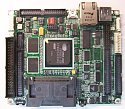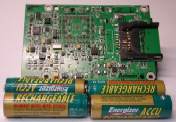Two compact ARM-based SBCs debut at ESC
Mar 8, 2005 — by LinuxDevices Staff — from the LinuxDevices Archive — views Applied Data Systems (ADS) has announced two new SBCs (single-board computers) at the Embedded Systems Conference in San Francisco this week. Both the Sphere SBC (pictured at left) and the UAV-X SBC are based on ARM processors, and both of them support embedded Linux, according to ADS.
Applied Data Systems (ADS) has announced two new SBCs (single-board computers) at the Embedded Systems Conference in San Francisco this week. Both the Sphere SBC (pictured at left) and the UAV-X SBC are based on ARM processors, and both of them support embedded Linux, according to ADS.
(Click here for larger image of the Sphere)
The Sphere
ADS claims that the Sphere SBC packs the “greatest amount of integrated power in the smallest space.” The 4 x 4 inch board is based on a 200 MHz Cirrus EP9315, a system-on-chip processor containing a 32-bit ARM9 CPU core enhanced with Cirrus's MaverickCrunch Math Engine. Additionally, the board provides three USB Host and three serial ports, and 10/100 Mbit/sec Ethernet, CAN 2.0 b fieldbus, AC 97 audio, SPI, and I2C interfaces.
From a mechanical design perspective, the Sphere is tuned to the environmental requirements of enclosed and mobile applications, according to ADS, and it features low power consumption and industrial ruggedization.
The UAV-X
 ADS's other new SBC is the UAV-X, which, as its name implies, is targeted at military applications such as air, land, sea, or subsea unmanned autonomous vehicles (UAVs). It's also useful for intelligent security cameras, “leave-behind” monitoring stations, and submerged or floating monitoring buoys, ADS says.
ADS's other new SBC is the UAV-X, which, as its name implies, is targeted at military applications such as air, land, sea, or subsea unmanned autonomous vehicles (UAVs). It's also useful for intelligent security cameras, “leave-behind” monitoring stations, and submerged or floating monitoring buoys, ADS says.
The ruggedized 9-inch-square SBC is based on a 500 MHz Intel PXA270 processor, from which it derives a performance edge over other SBCs that are currently being used in UAVs, ADS claims. The PXA270 features that are oriented towards handheld mobile devices such as cell phone and PDAs contribute to making the Sphere a uniquely competitive product in UAV applications, according to ADS. These include the chip's 4 megapixel image register, DSP functions, and extensive power management. Additionally, the Sphere can be expanded via CompactFlash and SDIO plug-in cards, and it provides USB host and function ports, three serial ports, AC97 audio, SMBus, and ADS's “SmartIO” interfaces.
This article was originally published on LinuxDevices.com and has been donated to the open source community by QuinStreet Inc. Please visit LinuxToday.com for up-to-date news and articles about Linux and open source.